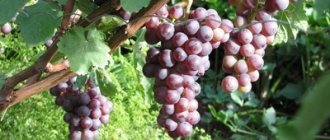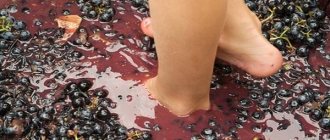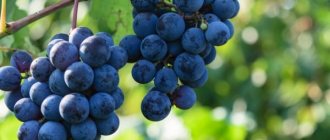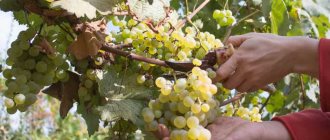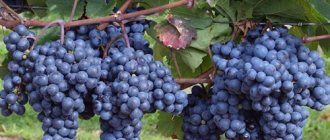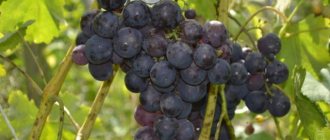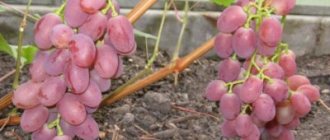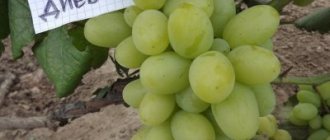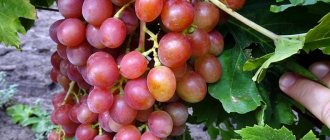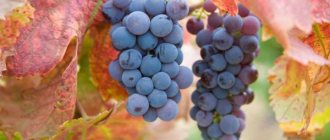Description
The history of official recognition of the Muromets variety is very long, 26 years long. This variety was bred in 1962 at the Central Genetic Laboratory named after I.V. Michurin as a result of crossing the Pobeda and Severny varieties by breeders I.M. Filippenko and L.T. Shtin. The “northern” variety endowed its “child” with frost resistance and early ripening, and “Pobeda” with high yield and good taste characteristics. In 1977, state variety testing began, and only in 1988 “Muromets” was included in the register of breeding achievements of the Russian Federation. But this variety won people’s love almost immediately after its “birth”.
Parents of “Murom” – “Pobeda” and “Northern”
Variety Muromets
Among these are the Muromets grapes. The variety is quite old.
Many generations of winegrowers have managed to enjoy its sweet berries. Today, there are new breeding products that may be superior to this variety in some qualities, but winegrowers are in no hurry to part with one that has proven its properties for decades.
Official information
The first ripe bunches of grapes appear in the first third of August.
Variety testing of “Muromets” was carried out for 12 years, and in 1988 it was entered into the register of selection achievements under number 7710682.
Applicant for the introduction of a variety into the register of the Federal State Budgetary Institution "Federal Scientific Center named after. I. V. Michurina Tambov region. Michurinsk, Russia.” The originators of the variety are the Federal State Budgetary Institution "Federal Scientific Center named after. I. V. Michurina Tambov region. Michurinsk, Russia, and the North Caucasus Federal Scientific Center for Horticulture, Viticulture, Winemaking, Krasnodar, Russia.
The variety is recommended for cultivation in the North Caucasus, Lower Volga and Ural regions as it has a very early ripening period.
Description of the variety
The variety is frost-resistant.
- The leaf blade of "Muromets", according to the registry, is medium in size . However, the majority of winegrowers say that the leaf is often large, and sometimes very large, and this does not depend on the degree of fertilizing.
- Medium dissected leaf . Moreover, the same bush has two types of leaves, so it is necessary to identify the variety by leaves in a comprehensive manner. The stepson leaves are completely different from the main ones.
- The leaf pubescence is weak , bristly along the veins.
Bunch and berry
Grapes have a high degree of sugar content.
At the time the variety was introduced into the register, it was considered that the bunch weighed 400–450 g and was large. At the moment, of course, we understand that this is an average bunch. The shape is conical, the density is average, the stem is short.
- The berry has an average weight of 4–5 g and is oblong-oval in shape.
- The berry is not homogeneous and the decrease in its mass cannot be called peas, but the size varies with a difference of one, or even one and a half grams. Winegrowers note that the size of the berries varies depending on the load. When overloaded, it produces more bunches, but the berries become smaller.
- It is very easy to achieve large berries from this variety; it is enough to standardize it well and it will reach 6, or even 8 g .
- The tendency is also clearly visible that only small berries do not carry a seed, while large ones always contain families.
- The skin is dark blue, closer to purple, thin, edible . When fully ripe, the berry is almost black in color and covered in a thick waxy coating.
- Each berry carries 1–3 seeds.
- Berries are often found without seeds. At the same time, if some winegrowers constantly register seedless berries, others only in some years.
- When fully ripe, the seeds are dark in color.
Trepang with honey - properties of the tincture. How to take and what helps tincture of sea cucumber with honey
Taste
The taste is rich and bright without any extraneous spicy aromas.
When describing the taste, many say that it is simple. There are no special nuances in the taste of Muromets.
- When you taste the berry, you will not feel a special taste or aftertaste, but you will feel a pleasant sweetness. This berry will not cause discomfort and “overkill” of taste, but the sweet harmony will attract the berry lover to itself.
- Some winegrowers compare the taste of the berry to black cherries, without aroma, but pleasant and harmonious.
- The grapes are classified as table varieties. Now, with the influx of European varieties, we want more and more new aftertastes. In the Soviet 80s, these grapes seemed like a very tasty dessert.
- The bunch can hang on the vine for a long time . At the same time, it will not add any taste or aroma, but the percentage of sugar will be higher. Since this variety is the first to ripen, many note that it is eaten so quickly that sugar does not have time to accumulate.
"Habits" of berries
In case of severe frosts, it is better to build a shelter for the plant.
The fact that “Muromets” sometimes bursts is noted by many winegrowers.
However, it should be noted that, unlike “Kodryanka”, “Timur”, “Arcadia”, the fracture site of this variety quickly dries out and never rots.
Some note the fact that it is possible to notice that the berry has burst only when cutting, as far as this drawback is minimal .
Characteristics
The “Muromets” variety is a black table grape: it can be eaten fresh, as an ingredient in desserts and fruit salads, and in jam. Drinks (juices, compotes) and dried fruits go well with it. The bright color of the berries, light sourness and interesting flavor bouquet make it possible to produce exquisite table and dessert wines from the variety. Such varieties as “Victoria”, “transformation” and “kesha” also deserve attention.
Ripening period
The duration of the fruit ripening period from the start of budding is 105 – 110 days. This allows us to consider the variety to be very early: the harvest can begin to be harvested already in the first ten days of August. Although this period may shift depending on the growing region and prevailing weather conditions.
Bush
“Muromets” is a vigorous plant, the length of its branches reaches 2.5 – 3 meters. The shape of the bush can be any, as long as the vine is well ventilated. Most often, the variety is formed in the form of a double-sided horizontal cordon, and if it is necessary to insulate the lashes for the winter, a standard-free fan formation with 4 to 6 sleeves is used.
The flowers of the variety are bisexual, which ensures successful pollination of the inflorescences. The leaves are round in shape and light green or gray-green in color. Petioles are reddish in color.
bunches
The average weight of grape bunches is 500 g, but with proper care, the weight can increase to 1 kg. The average length is 25 – 30 cm, the shape is cylindrical-conical, the density is average or above average.
Important! Experienced winegrowers note an increase in the size of the bunches and berries of “Muromets” when growing vines on an arch, gazebo or canopy.
Berries
The grape berries also have an impressive size: the size of each grape is approximately 2.5 by 2 cm, weight - about 5 g, shape - elongated oval. Visually, each berry looks approximately like a five-ruble coin. But it is possible to have berries of different sizes in one bunch (the difference is 1 - 1.5 g). Large berries contain 1–3 dark-colored seeds, while small ones may not have them.
Winegrowers note that the size of the berries depends on the load: overload gives more grapes, but the size of the berries suffers.
The berries are dark purple, almost black, and covered with a thick waxy coating - pruin, which helps protect the fruit from pests and mechanical damage. You can increase the size of the berries (up to 6 - 8 g) by normalizing the load on the bush, as well as by thinning the berries in clusters.
The pulp is juicy, dense, crispy. The skin is thin, chewing it does not cause any difficulty.
The variety has high sugar content (18 - 20%) with an acidity of 8.5 g/l.
Taste
“Muromets” grapes have a pleasant, harmonious taste with a slight taste of black cherries and notes of “rose petals.”
Grapes "Muromets": how to preserve bunches (video)
Biological description
The plant is vigorous, the length of the shoots can vary from 2 to 3 m. The ripening of the vine is very high and ranges from 2/3 to 6/7 of the total length. The Muromets grapes are characterized by high yields, varying from 12 to 16 t/ha. The shoots have sparse cobwebby pubescence.
The leaves have a medium-sized plate of pentagonal and seven-lobed shape. Anthocyanin staining of the main veins on the lower part may be observed. The matte surface part of the leaves has net wrinkles and a grayish-green color. Petioles are brown-red. The flowers are bisexual.
The bunches of Muromets grapes are very large. Characterized by medium density and slightly conical shape. As a rule, the average weight of a bunch of grapes varies from 300 g to 500 g, which depends on care and weather factors.
Technical specifications
The “Muromets” grape variety produces fairly large berries, weighing more than 5 g. The main color of the skin of a fully ripe berry is dark purple. The berries are covered with a slight waxy coating.
The grape pulp of this variety is very juicy, fleshy, with a characteristic crunch, without a strong pronounced aroma. The taste is very harmonious and pleasant. Ripe berries are highly marketable. The acidity of the wort does not exceed 6 g/l. Sugar content is just over 17%. The berries contain fully formed seeds, the number of which can be from 1 to 3.
Advantages and disadvantages
The Muromets grape has many advantages:
- excellent resistance to diseases such as mildew and gray mold;
- very high level of frost resistance, reaching -25-26 °C;
- the collected berries are suitable for long-term transportation and long-term storage;
- the yield can reach 7 kg from each grape bush;
- high marketability of ripened berries;
- shoots ripen almost to the end of growth.
The disadvantages of the Muromets grape variety are few:
- severe cracking of berries at the ripening stage in too hot weather after heavy watering;
- the variety is not resistant to oidium;
- grapes are attractive to wasps.
In addition, peas can sometimes be observed, which becomes widespread in insufficiently warm weather.
Comparison with analogues
Let’s compare “Muromets” with similar large-fruited varieties.
| Sign | Variety | |||
| Muromets | Furor | Laurent | Attica | |
| Ripening period | 100-110 | 105-110 days | 110-115 days | 115-120 days |
| Frost resistance | Up to -26 °C | Up to -25 °C | Up to -23C | Up to -23C |
| Yield per bush | 15 kg | 15-30 kg | up to 50 kg | 15 – 20 kg |
| Bunches | 500-1000 g | 900 g | 500 g - 2 kg | From 700 g to 2 kg |
| Taste | Harmonious, with a slight taste of black cherry and notes of “rose petals” | Nutmeg-fruity aftertaste | Fruity notes | Fruity notes |
| Color | Dark blue | Dark purple, almost black | Dark blue | Deep purple |
| Disease resistance | High | High | Above average | Average |
| Shelf life | 1-2 months | A few months | 1 – 2 months | Up to 2 months |
| Sugar content | 18-20% | 21-23% | 18-19% | 16 – 19% |
| Acidity | 6-9 g/l | 5-7 g/l | 6-6.5 g/l | 5 g/l |
Advantages and disadvantages
A comparison of the characteristics of the Muromets variety with other varieties of table grapes indicates a clear advantage of this variety:
- high winter hardiness (tolerates frosts down to -25 degrees without shelter);
- early ripeness (ripens in early August);
- ease of care;
- rapid growth of shoots;
- resistance to mildew;
- The berries are juicy, the skin is thin and tender, the seeds are small.
We cannot remain silent about some of the disadvantages of this grape variety:
- tendency to peas when tying a large number of tassels;
- drying out of berries in a bunch during drought and cracking in rainy summers;
- susceptibility to the disease gray rot.
The Ilya Muromets grape variety has been grown in the gardens of our country for more than 50 years. Its unpretentiousness and high yield make it possible to recommend the crop for cultivation to gardeners taking their first steps in viticulture.
Features of cultivation
A standard set of agrotechnical measures will ensure a high yield of the variety: planting on neutral soil, regular loosening of the soil, 2 feedings per season with mineral fertilizers, moderate watering.
Trimming
The maximum permissible load on a bush is 40 – 45 shoots. The vine is pruned to 8 - 10 buds. Particular attention must be paid to normalizing the load: it happens that heavy branches simply break under the weight of the bunches. Therefore, it is recommended to leave 1 inflorescence per shoot.
Resistance to diseases and pests
The register of breeding achievements contains information about the high resistance of “Muromets” to mildew and vulnerability to gray rot. However, experienced winegrowers have doubts about the first fact: the fungus successfully mutates and can quite realistically “populate” this variety.
Timely preventive treatment of the plant with fungicides will help prevent such troubles: Smilix, Switch, Sporobacterin, Thanos.
Of the pests, wasps pose the greatest danger to Muromets. It is important to prevent them from nesting in the vines. To prevent pests from damaging the crop, you can place sweet baits with poison near the bush.
Wintering
“Muromets” can tolerate temperatures down to -26ºС. Mature bushes do not need to be covered, but plants that are not yet 3 years old are recommended to be insulated. Some winegrowers simply remove the vines from the support and lay them on the ground, without sprinkling anything on top.
Harvest storage
Important! The variety’s performance is quite high: 14–15 kg per bush and 13–16 tons per hectare.
The Muromets variety can be stored for 1 – 2 months at a temperature of +3ºС – +8ºС (cellar, refrigerator). Grapes are well transported if they were harvested in dry weather.
Regions
“Muromets” is successfully cultivated in the North Caucasus, Lower Volga and Ural regions, as well as in the Moscow region, the North-West, Siberia and the Far East.
Diseases and pests
The variety has good resistance to fungal diseases (mildew, oidium), but has poor resistance to gray rot.
A gardener should definitely take preventive measures to avoid problems when growing grapes.
- Be sure to carry out preventive treatment of bushes with chemical solutions. Particular attention should be paid to treatment against gray rot;
- Carefully care for the plant: water it abundantly, feed it, cultivate the soil, trim branches twice a year (in spring and autumn);
- Collect fallen berries and leaves under the bushes in a timely manner and burn them, as they can become real breeding grounds for pathogens and pests;
- Pay attention to protection against wild wasps. Place traps, spray, destroy wasp nests.
Don’t forget to prevent such common diseases as anthracnose, bacteriosis, chlorosis, rubella and bacterial cancer. How to carry out these events correctly, read in separate materials.
Muromets is a favorable table variety for growing in a suburban area. It is preferred for its good taste, presentation, aesthetic beauty, and frost resistance.
Varieties such as Romeo, Taifi and Sofia can attract attention with particular beauty.
The disadvantage of the variety is weak immunity against diseases (especially against gray rot).
Reviews
The berries fully live up to their name. The bush never suffers from any misfortune. It ripened already at the beginning of September, and you yourself understand this is important for Siberia. Maria, Siberia
In fact, this is the earliest variety I have. The taste is not particularly different, but since the very first one comes, it is eaten in a moment) The bush gave its first fruits in the 3rd year with a total harvest of up to 6 kg. Nikolay, Perm
For a dacha gazebo, Muromets fits the article perfectly. I don’t visit the dacha very often, but in its 8 years this variety has never gotten sick, never frozen, and the harvest is always good. Ivan, Nizhny Novgorod
Muromets is a good option for a vineyard. Minimal maintenance, versatility in use and attractive appearance will be appreciated by households, guests and buyers.
Selecting a site for planting
For the vineyard, sunny areas protected from strong winds are traditionally chosen. Bushes are often located near the walls of buildings on the east or south side. The wall, heating up during the day, in the evening and at night, radiates the heat that the grapes need so much.
Tomato Ilya Muromets
For planting grapes, soils with a neutral reaction, loose, and with low groundwater levels are chosen. Loams and sandy loams enriched with rotted manure and a complex of mineral fertilizers, enriched by the addition of sand and humus, are suitable. Approximate dosage of fertilizer application before planting grape seedlings per 1 sq. meter:
- rotted manure (horse, mullein) 10 kg;
- wood or grass ash 600 g;
- superphosphate 350 g.
Important! A layer of coarse crushed stone, 5 cm thick, must be poured onto the bottom of the planting holes for drainage. The roots of the plant are especially sensitive to stagnant moisture.
Landing
Planting grapes in a hole
Grape seedlings are placed in the ground in spring, early May or August. Planting holes are dug in the prepared area, 45–55 cm deep. For the Muromets variety, taking into account the dimensions of the bush, the distance between the holes should be at least one and a half meters.
Grapes Nadezhda Aksayskaya
Immediately insert a piece of rubber hose or plastic pipe into the dug hole so that a part 20 cm long protrudes above the surface of the ground. Holes are made at the lower end of the hose. The pipe is necessary for further watering and fertilizing of the grapes; through it, moisture can penetrate directly into the root zone of the plant.
Trellis for grape shoots are installed in advance. The hole is filled with soil mixed with fertilizers. The seedling is placed in a hole so that the graft on the stem remains above ground level.
Important! After planting, the bushes are watered abundantly, spending at least 15 liters of water for each plant. The soil around the grapes is mulched with straw and wood shavings.

